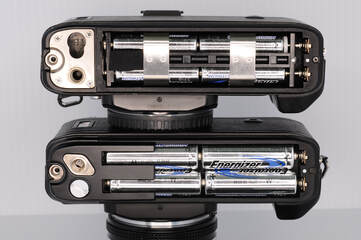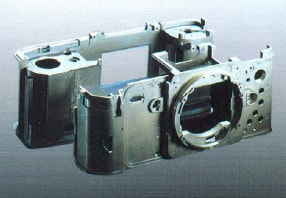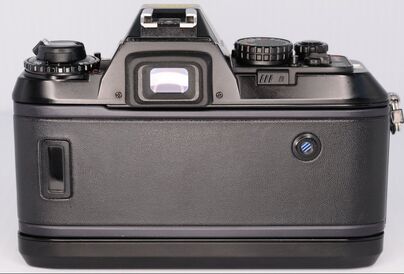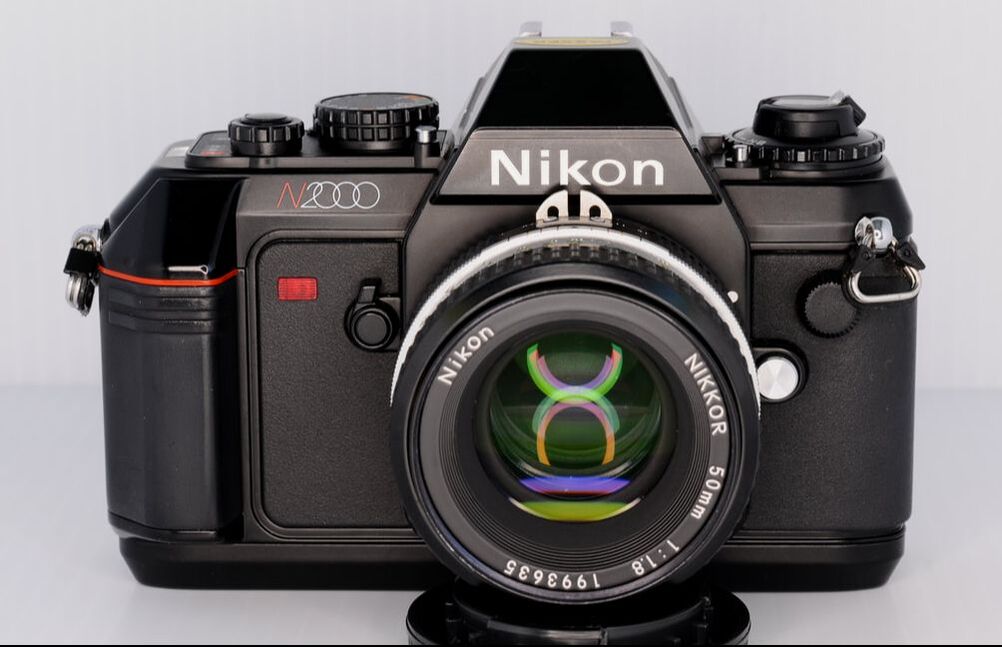|
Updated May 10, 2024 Ka-Chang! Ka-Chang! Ka-Chang! The 1980s were anything but unobtrusive, so it should come as no surprise that the N2000 (F-301 outside of the US & Canada), Nikon's first SLR with internal, automatic film winding, was not bashful in its efforts to advance 35mm film to the next frame. This by no means distinguished it from its peers as there were no truly quiet motorized film advances until the '90s came along. Long spurned by Nikonistas due to its cardinal sins of: 1) Complete battery reliance, 2) Hybrid construction (READ: it's not all-metal...gasp!), and 3) Automation for everything but film rewind and auto focus, the N2000 is an all-time sleeper among Nikon SLRs (although the ruckus it makes when you squeeze the shutter release would serve as an effective alarm tone on your smartphone ;-)). It was Nikon's last proper, in-house, clean-sheet, manual focus SLR design (don't get me started on the FM-10/FE-10 imposters or the oddball N6000/F-601M that supposedly replaced the N2000, but was just a de-contented MF version of the AF N6006/F-601). But there was more to this under-the-radar SLR than just a fancy film advance system. A Long Time Coming (and Running) The gestation of the N2000 was a long one. The two cameras that kicked off the internal film winding SLR gambit, the Konica FS-1 and the CONTAX 137 MD Quartz, debuted in 1979 and 1980, respectively, and then were both updated into the FT-1 and 137 MA Quartz in 1983. You can tell that Nikon engineers gave both of those models (particularly the CONTAX) a long, hard look during their development of the N2000. Two years later, the first all-new Nikon SLR chassis in over five years was introduced in September 1985. The N2000 would last on the market until September 1992 (production obviously ended earlier than that :-)), and sell over 1.3 million copies along the way; not a bad run for a manual focus SLR that came out seven months after the AF SLR revolution began :-). With it, Nikon initiated their regional nomenclature for all non-professional film SLR models: with the "Nxxxx"-prefix for the USA and the "F-xxx"-prefix for other international markets. The N2000, along with its near-twin, the AF-capable N2020/F-501 (April 1986), would prove to be the last SLRs to sport the classic F2-stylized "Nikon" embossed into their prism housings. All subsequent models would use the italicized "Nikon" script (excepting the limited run 50th Anniversary F5, which resurrected the original font from the Nikon 1 rangefinder :-)). The N2000 was the direct replacement for the manual-advance FG & FG-20 cameras (which could be fitted with an accessory MD-14 motor drive), and the progress made with it is best seen in that context. Besides the integrated motor drive, other new features (for a Nikon, at least) included:
 MB-4 AAA (top) & MB-3 AA (bottom) MB-4 AAA (top) & MB-3 AA (bottom) The big thing was, undoubtedly, the integral film winder. A bare FG equipped with the MD-14 and its eight alkaline AA batteries weighed on the order of 1025 grams (36.1 oz) and had a maximum frame rate of 3.2 frames per second (fps) on High, and 2 fps set to Low. There was no selection between Single or Continuous advance. You had to press and release the shutter release relatively quickly to prevent taking more than one frame sequentially. The N2000 with four AA batteries installed (this required using the optional MB-3 battery cover in place of the standard MB-4, which held four AAAs) cut that to 670 grams (23.6 oz); a considerable savings of 35%. It still achieved a very respectable (for the day) 2.5 fps, which was impressive considering it had half of the amperage of the MD-14 at its disposal. An AA-powered N2000 was also far more efficient, able to run through 180 rolls of 36 exposures versus the 50 or so of the FG/MD-14 combo on a single set of alkaline batteries at room temperature (as are all of the ratings in this article). While there was no H/L setting on the N2000, it did allow for selection between (S)ingle and (C)ontinuous advance, which was plenty for its mid-consumer-level status. As far as noise is concerned, a bit of perspective is in order. To a 21st-century ear (with our piped-in exhaust noise for sports cars and fake shutter clicks on our smartphones ;-)) the N2000 is noisy. But for its time, it was average or even a bit below-average. And when compared to many concurrent external motor drives or winders, it was actually a noticeable improvement. Just for casual comparison I took one of the more discreet SLRs of its era, the Minolta XD-11 (565g/20 oz with 2 - SR44 batteries), and popped on its accessory Auto Winder D (265g/9.3 oz with 4-AA Lithiums; 2 fps max.) and put it up against the N2000. With a Realistic #33-2050 sound meter positioned 30.5 cm (12") from the loudest part (between the front grip and lens mount of the N2000, and the rear central portion of the Auto Winder D, where the motors were located...go figure ;-)) of the tripod-mounted cameras with no hands or fingers to alter the dispersion of sound, the Nikon produced 73 dB while the Minolta punched out 76 dB (both were set to 1/250 sec. shutter speed). But it's not just about peak sound levels; the Minolta winder was higher-pitched and the cycle lasted at least twice as long, making for a much more noticeable frame advance. The N2000 also more than held its own in relation to its internal-winding peers: the Canon T-70 (2 AAs; 1.2 fps ouch; 40 rolls of 36), the Minolta 7000 (w/ optional 4-AA holder BH-70L; 2 fps; 40 or so rolls of 36), the Pentax A3000/A3 (2 AAs; 1.5 fps; 50 rolls of 36), the Konica FT-1 (w/ optional 4-AA holder; 2 fps; 40 rolls of 36), and its closest competitor, the CONTAX 137 MA Quartz, to which the N2000 bears more than a passing resemblance in the battery compartment and film back areas ;-)). With its four AAs, the 137 MA Quartz outdid the N2000 in frame rate (3 fps), but at the expense of battery life (50 rolls of 36). To put all of those numbers in context, most accessory autowinders (if available) for manual-advance SLRs at the time used 4 AAs and did 2 fps on average (like our Minolta Auto Winder D). Nikon's advertising claim that the N2000 had the fastest integral motor in its "class", relied on its Program modes to distinguish it from the 137 MA Quartz which had "only" Aperture-priority and Manual modes. Such hair-splitting to claim superiority over competitors had become firmly entrenched by the mid-'80s as the SLR bust was in full swing and manufacturers were seeking to grab every last percent of market share from each other.  The chassis of the N2000/F-301. The chassis of the N2000/F-301. The N2K in the 21st Century Public Enemies 1, 2, 3, & 4 (aside from Nikonistas ;-)) for an N2000 are the alkaline batteries that have been used to power the vast majority of these cameras for the past 35+ years. More of these bodies have been rendered inoperable by those treacherous little barrels of leakiness than you can shake a jug of vinegar and a handful of Q-tips at (which is what you will need at the very least to clean any corrosion left behind). Two tips:
Many times you will hear of or read about the "plasticky" construction of the N2000 (and its AF near-twin, the N2020/F-501). Some clarification is necessary. It was not the first Nikon to use plastics by a long shot: the EM (1979) and its FG (1982) and FG-20 (1984) progeny, sported polymer top and bottom plates, and a less solid but still very decent feel, long before it. And even the enthusiast-level FA (1983) utilized such materials for its top plate. While it is true that the N2000's top plate & most of its controls, the trim plate surrounding the lens mount, and the interior of the battery compartment are all polymer or polycarbonate (which technically makes for "hybrid" construction), this is not a flimsy, creaky, or cheaply-constructed camera. The chassis was formed from two substantial aluminum alloy castings (using the same alloy as the F3 and the FM/FE/FA bodies) with all of the plastic bits screwed to said castings (the three rubber front grip panels are also directly attached to the front casting with double-sided tape). So, while it is not unusual to find hairline cracks in the admittedly thin polycarbonate of the top plate on either side of the model number, structural integrity is not compromised in such a situation. Of course, if you slam the camera around like a wannabe war photographer, it's not going to enjoy it ;-). The film back was still made from aluminum as was the bottom plate/battery cover (which could not be said of many of its peers in 1985), so you still got that true metallic cool-to-the-touch vibe when cradling the N2000 in your hands. You want to talk about plasticky Nikons? Grab an N/F50, 55, 60, 65, or 75 or an FM/FE-10 and then tell me the N2K feels cheap and flimsy. Oh, and no "sticky grip syndrome" to be had, either :-). As far as lens compatibility goes, the N2000 is pretty darn solid among manual focus Nikon bodies. It will meter with almost any AI-modified *, AI, AI-s/Series E, or AF(-D) Nikkor lens. There are a couple caveats when metering in the two Program modes with AI-modified lenses (which lack the internal AI lug found on the mount of all actual AI, AI-s/Series E, and AF(-D) lenses) that the instruction manual details on page 37. If you are going to be a hardcore Program user, simply using actual AI or AI-s/Series E lenses makes this a moot point, or if you already have AI-modified lenses, using Aperture-priority or Manual will also mitigate any possible issues with obtaining proper exposures. Non-AI lenses will not mount on the N2000 without causing damage to the AI coupler, SO DO NOT ATTEMPT IT :-). While Nikkor "G" AF lenses will mount on the camera, their lack of an aperture ring and AI tab means that they will not meter and you will only be able to shoot them at minimum aperture as there is no way of controlling the aperture from the camera body. Nikon accordingly classifies G lenses as incompatible with the N2000 in all exposure modes, including Program. Putting an AF lens on an MF body sort of defeats the purpose anyways, no? But if you want to, knock yourself out :-). * AI-modified lenses that cannot be used on the N2000 are: Nikkor 55mm f/1.2 (Serial Nos. 184711-400000), Nikkor 28mm f/3.5 (Serial Nos. 625611-999999), and Nikkor 35mm f/1.4 (Serial Nos. 385001-400000). A couple of nice features when you use the camera in "A" mode are: 1) When you engage the AE lock, the locked shutter speed glows steadily in the viewfinder display while the current meter reading blinks so you can instantly see how much of an exposure difference there is between the two values, and 2) When using TTL flash, the 1/125 sec. sync. speed glows steadily while the metered reading without flash blinks to again alert the user to the difference between the two.  Rear view with DK-16 eyecup installed Rear view with DK-16 eyecup installed (Possible) Drawbacks As with any SLR, there were compromises incurred by the price point and design choices made with the N2000 such as:
Wrap-up Today, the N2000 lives in the same space occupied by other consumer Nikon SLRs. It is shunned by Nikonistas (aka "real" Photographers; note the capital "P"...very important) because it's not an F3 or F4 for a fraction of the price (I mean come on Nikon, get it together ;-)). However, when viewed in proper context, it was very competitive with its contemporaries, and is currently stupid-good value for the money. Consider for a moment what you get:
That's a pretty stout feature-set for $50 USD or less for a Very Good to Excellent grade copy from a reputable retailer with warranty any day of the week, and for even less than that should you choose to take your chances online-auctioning or in a thrift store. An equivalent-condition FG with the getting-rare MD-14 motor drive included will be $150 USD, minimum. Buying the MD-14 separately will take $75 USD, alone (that's MD-4 price territory :-0). Which makes the N2000 look pretty stinkin' good for the money (and remember that it's 35% lighter) if you want powered film winding in a manual focus Nikon. If you can live comfortably with its compromises (remember that every SLR has them :-)), you can't beat the value. Perhaps the most apropos term for the N2000 is: Tweener. Stick it in between an FE2 (1982) and an N8008/F-801 (1988) and you clearly see the transitional character of the camera when it comes to controls and ergonomics. It also straddles the line between consumer affordability & simplicity and enthusiast capability. That makes it great for a first SLR or as an add-on to a battery of Nikon bodies for those situations where you don't want to risk a more valuable piece. Maybe Daijiro Fujie, designer of the N2000/F-301 viewfinder and Briteview focusing screen (and also, coincidentally, the vaunted AI-s 28/2.8 Nikkor lens) summed it up best when he recommended it to a younger colleague with honest humility: not a high-end, professional sort of camera, but a good camera nonetheless "...a good camera nonetheless." So don't let the Nikonistas get to you...just put some earplugs in ;-), run your finger over your N2000's or F-301's thin red line, snap that bright viewfinder into focus, and blast away. Ka-chang...ka-chang...ka-chang... References: Nikon N2000 Instruction Manual Nikon History - Camera Chronicle: Part 15: "Nikon F-501" & "F-301" Nikon History - Camera Chronicle: Debut of Nikon F3 Nikkor - The Thousand and One Nights No. 57 - by Kouichi Ohshita Contax 137 MA Quartz Instruction Manual @ www.butkus.org/chinon Contax 137 MA Quartz Dealer Notebook Pages c.1987 @ www.pacificrimcamera.com First Look: Nikon N2000 Popular Photography Nov. 1985 Nikon Compendium: Handbook of the Nikon System by Hillebrand & Hauschild Nikon N2000 Brochure - June 1985
10 Comments
Barkisiswillin
8/15/2021 01:44:26 am
What a good write up! I took delivery of one these yesterday for 35 euros, in perfect condition, and it's a great (essentially free) camera. The thing I don't like about it, in common with FEs, is that the exposure lock is physically painful to use, though very handy for a centre-weighted meter. It's odd that Nikon made it this way, and then waited until the FM3A to fix it. Thanks to this (simple?) redesign, the FM3A became a pleasure to operate.
Reply
C.J. Odenbach
8/15/2021 07:09:49 am
Glad you enjoyed the article and congratulations on your new-to-you camera! I think most people would agree that the AE-L button location on the FM3A was a vast improvement ergonomically. By the time that the FM3A came along, enough time had passed since Nikon adopted the rear location of the AE-L button on the N8008/F-801 and then settled on it through the '90s for the rest of the enthusiast and pro bodies that when it came time to design it, they wanted that ergonomic continuity with the AF lineup. Just a hunch :-). Take care.
Reply
Mel Jones
8/23/2021 05:25:15 am
I used a pair back when they were in production as backups to some F models. I always found them to be exceptionally good to shoot with and the Program mode the most reliable of any program mode camera.
Reply
C.J. Odenbach
8/23/2021 09:42:02 am
Hi Mel. Great to hear from you, as always, and particularly with your background with the F-301. It's funny how often people state that it was Nikon's first "plastic" camera, when in reality it was the first one to not try and hide that fact ;-). The flip side: that is precisely what has kept values down and makes it my nominee for the best bang-for-the-buck MF Nikon film body at this point :-).
Reply
C.J. Odenbach
9/19/2021 12:28:14 pm
Glad you appreciated it, Bernhard. Take care.
Reply
This is the best write-up I’ve seen on this camera, hands down. The lack of respect for this camera worked in my favor as I got mine for $20 with its original box and never-ready case at one of my local camera stores.
Reply
C.J. Odenbach
9/24/2021 08:21:38 am
Congratulations on a great buy, Robert. The analogy of the shoes when comparing the handling of the N2000 and 137 MA is spot-on (at least for me) as well. I have heard good things about the IKEA Laddas more than once and it sounds like you are set when it comes to power. Thanks for the thoughtful comment and best regards.
Reply
Steve Shorey
12/16/2021 08:05:47 am
Very nice little review CJ. I have been a film user my whole life. Minolta SRTs served me well for decades until digital crept in. About 16 years I spotted that 35mm gear was dirt cheap on eBay and in junk shops and I bought a lot of older gear..but never NIKON. 6 weeks ago we were at a Vintage Car spares meet (here in the UK) and I spotted an unmarked F301/N2000 on one of the tables. After chatting to the guy he realised I would actually use it and sold it to for just 20GBP with zoom and case. The test roll showed the cheap stock Nikon zoom is not brilliant..but have invested in a used 50mm AIS F1.8. Happy Festive Season. Steve
Reply
C.J. Odenbach
12/16/2021 08:27:42 am
Glad to hear it, Steve. And thank you for sharing your story. I never get tired of hearing from others about the deals (and steals ;-)) they find. You can't go wrong with the 50/1.8. Enjoy and take care.
Reply
Your comment will be posted after it is approved.
Leave a Reply. |
C.J. OdenbachSuffers from a quarter-century and counting film and manual focus SLR addiction. Has recently expanded into 1980's AF point and shoots, and (gack!) '90s SLRs. He even mixes in some digital. Definitely a sick man. Categories
All
Archives
June 2024
|

 RSS Feed
RSS Feed